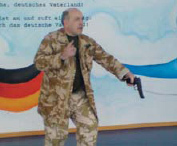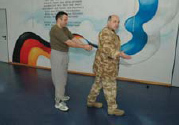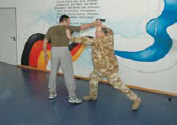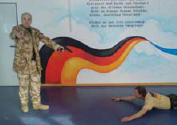Some military-philosopher guy once said that war is a series of mistakes and the side that makes the least mistakes wins. Veterans reading this will laugh because they will already have seen that most wars are a series of cock-ups. Just so you don’t get the idea that I think I know everything, let me tell you a story where I was carrying a pistol as a reserve weapon and it did, sort of, come in useful. But when you have read the story ask yourself how often this is going to happen.
In Mozambique we had just cleared a base camp of some hundreds of enemy soldiers. We had helicopters with us to take out the wounded though we came in on foot. (I still have a soft spot for the old US Hueys born of gratitude.) The choppers were taking fire from the hills around the camp where there were a number of heavy machine guns sited – 12.7 to 22mm Russian weapons which would knock down an old chopper or at least make the pilot bad tempered. A certain US major sent me with nine guys to clear the top of one of the hills of anti-aircraft guns.
On hands and knees we climbed up this rock covered ‘Gomol’ as they call the hills there. When we got 30ft from the summit the guys dug in there started dropping hand grenades on us. An American lieutenant went quiet and we thought he was dead. A grenade landed about 3ft from my head and I just had time to think, ‘Oh Shit’, or similar, before it went off. I took 12 pieces of shrapnel down my right side from one which hit my right temple and slid along the bone above my eye to some in my thigh. One other piece somehow went through the sole of my left boot and into my foot. I must have had that leg crossed behind me – so the urban myth is untrue that lying with your feet towards a grenade will protect you.
The experience of being hit by shrapnel must vary according to where you are hit and your mental state at the time. Adrenaline numbs most things. For me it felt like what we used to call ‘dead leg’ at school – where someone knees you on the thigh and it makes the muscle go numb.
There turned out to be 600 of the opposition on the top of this hill. They were dug in to rock in tight trenches and it took a battalion of Special Forces later to get them out.
At this point I was quite tetchy because I thought I was going to be left there as it was getting dark and the team were being forced back down the hill. Fortunately it was just my right eye which was closed by the blast so I was able to sight my rifle with my left and knock off the heads which appeared over the crest. Trouble was, when I tried to move from the isolated rock I was hiding behind a hail of bullets drove me back to cover. A young Welshman named Taffy Davies was quite close and he provided covering fire to keep their heads down and suppress their fire as I moved from my rock. Taffy opened fire and I hobbled out for the next rock down the hill holding my pack in one hand and my rifle in the other. Out in the open my pack was shot out of my hand and then a round hit my rifle knocking that out of my hand as well and sending it spinning down the mountain. I kid you not. It didn’t take me long to reach cover but I was breathing heavily.
Drawing my Blackhawk reserve revolver like John Wayne I lead the team back down the Gomol to our base camp in the dark, limping. Happily, I didn’t have to test my aim with this heavy sidearm as I was getting woozy from loss of blood. I was casevaced out later and stitched up. The American lieutenant had taken a piece of shrapnel in his backside and we were pleased to see him limp in later. Not being a Hollywood star, I had chosen to leave the lieutenant and save the rest of the team rather than search under heavy fire in the dark. This was the last time I carried such a heavy reserve weapon, changing afterwards to the excellent Berretta 9mm.
Pistol tactics
Civilians mostly get their knowledge of pistols from Hollywood. Police officers and cowboys dropping the bad guys with one shot from 100 yards. The reality just isn’t like that and you will never kill anyone with a pistol at more than about 10 yards. More likely 5. Remember I said ‘will not’ rather than ‘can not’. For that matter, TV and the movies often show lots of shooting with rifles, sub-machine guns and pistols at point blank range and no-one getting hit because of the laws relating to violence on TV in some places – reality ain’t like that either. You will pretty much always use your pistol at close range in a building, car or possibly a back alley. If that were not the situation you would be carrying a rifle. Spook work is a lot seedier than it looks on TV.

The Author teaching dirty pistol tricks to German SF in 2010.

Drag your feet until the gunman gets close and pushes.
Pistols are actually quite difficult to aim well because they are so short barrelled and most people need a lot of practice to get to be any good at hitting a target. But even people who are considered ‘well trained’ with pistols have learnt and practiced on a firing range – a one-way range where there is no one shooting back. And someone shooting back at you raises the art of pistol shooting to a whole new level. The sonic crack of bullets passing your ears puts some people off their stroke. At least it can make careful aiming an afterthought. I have just been discussing, with a friend in Germany who trains Special Forces for a living, the idea of having people shooting back on ranges and also taking recruits for Special Forces units specially to hot zones to get them shot at a bit to make them ‘steady’. There’s nothing like veteran troops who have been shot at a few times for an example of what ‘steady’ should look like.

Then disable him and take the gun.

Now take the gun off me! This is how you hold a prisoner when you have the weapon. A searcher should approach from the side. (Author’s Collection)
My main message about using a pistol when working undercover is that, depending on your situation and mission, very often the speed you can draw the weapon, or how well it is hidden, is as important as how well you shoot. Think about this: suppose three crooks hold you up at pistol point in a South American bar. They don’t know you are carrying a pistol so they are overconfident and sloppy. Only one keeps his gun on you and then not all the time. They have almost certainly not been trained on their weapons and every person they have threatened has been afraid of them. You act scared and wait for the moment. You draw and fire into the middle of each body, the most dangerous looking first. Then as they go down you close and put a shot in each head to make sure.
The main idea, I say, is to manipulate the situation so you catch the enemy by surprise. Then you don’t have to draw faster than they can pull a trigger. Perhaps you can even get yourself into a position where you have your gun out ready? Then, at a distance of a couple of yards, fire into the body and finish with a shot to the head. The reason for the head shot is quite simple. A lot of people wear body armour which will stop a pistol bullet or reduce its impact. Aim first for the body to be sure of a hit which will stop them killing you and knock them down. Then walk up and finish them off in your own time. There used to be a saying in the British SAS, ‘Two in the head and you know that he’s dead’. There’s nothing like making sure.
Holsters
Speaking of hiding, drawing and shooting, you will need a holster of some kind to carry your pistol in a ‘concealed carry’. As an undercover operator you need to hide your weapon well yet be able to get at it quickly. The balance between hiding and access means there is no clear favourite for holster type. Your holster can go on your same-side hip, against your backbone, in your crutch or under your opposite side arm. You will understand that in a covert situation these holster ‘carries’ have different advantages and disadvantages relating to speed and accuracy.